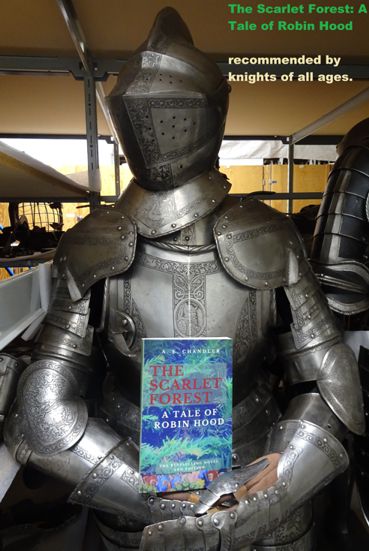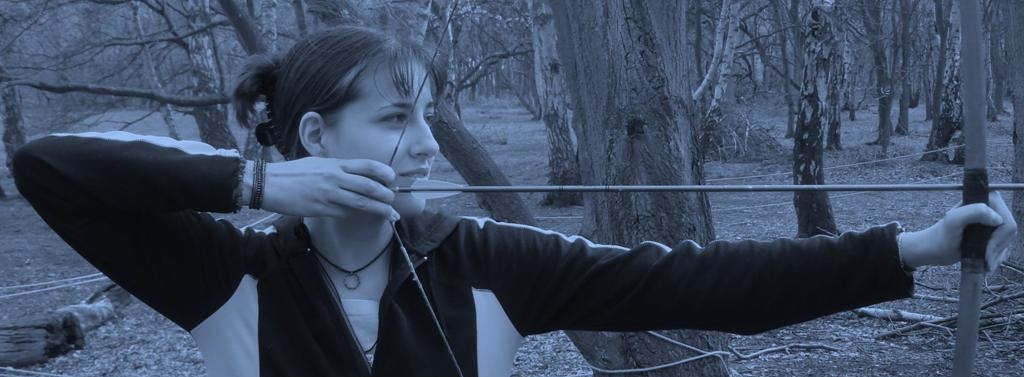
You are invited underneath the great greenwood tree to hear how a young man became a hero, and a hero became a legend. When Robin takes a shortcut through Sherwood Forest, the path he chooses leads not to Nottingham’s archery contest, but to a life on the run from the law. Unable now to become a knight, and joined by his childhood friends, Robin Hood leads the most infamous outlaw band ever to evade the king and his sheriff.
Blending true history with new stories, popular inaccuracies, and some almost forgotten medieval legends, The Scarlet Forest: A Tale of Robin Hood brings a new life to the greenwood, which here feels as fresh as it does traditional. With an academic background in medieval English studies, A. E. Chandler captivates with this unique and nuanced reinterpretation of Robin Hood’s struggles and adventures. The forest is waiting.
This expanded second edition contains bonus material, including a translation of one of only five surviving medieval Robin Hood “ballads,” two medieval recipes, book club questions, and a historical note.
Searching Out Robin Hood
Could anyone have really been as good an archer as Robin Hood is claimed to be?

(Creative Commons License)
The biggest obstacle to answering this question is knowing what kind of bow an English archer would have used. We can place the origin of Robin Hood’s legend sometime during the early to mid thirteenth century. Many people believe that the longbow came to England from Wales sometime after the middle of the thirteenth century, but this is false. It is also false that there was a weapon called a short bow that preceded the longbow. Until shortly before the end of the medieval period, there were only bows and crossbows. A bow was as long as it needed to be to suit the archer using it. What we now call longbows – what people at the time simply called bows – were present and in use in England long before Robin Hood’s legend was beginning in the thirteenth century. Every amazing feat of archery in the extant medieval stories is possible with a longbow, assuming the archer had the necessary skill.
What was it like living in Robin Hood Country for a year?
While I was working on my graduate degree in Medieval Studies at the University of Nottingham, I got to live right in the heart of England. I loved it, but it was an adjustment, from the food to the weather to how the light switches worked. Quite a bit of the time it was lonely, since my family and friends were back in Canada, and the time difference dramatically stilted communication, even with the Internet. That’s the necessary downside, but it was honestly the best year of my life. Not only did I get to study at one of the top universities in the world, but the number of sources and experts I was given access to was a dream come true. Most weekends I caught a train or a bus to another town or village and explored. Researching Robin Hood, and then actually being able to travel to the places portrayed in the legend, gave me a more complete view than I could have gotten anywhere else.
Most retellings use Richard I as their king; why did you choose Edward I?

Richard I was added to the Robin Hood legend in the sixteenth century. He wasn’t a very good king. He spent his time and England’s money on foreign wars, rather than on looking after the country. Medieval records show that some form of Robin Hood’s legend had spread to southern England by 1262. In The Scarlet Forest: A Tale of Robin Hood, I have Robin outlawed in 1260, which gives him the legendary “thirteen years and something more” to make a name for himself by 1262, and receive a pardon when Edward I returns from crusading in 1274. Richard I reigned during the twelfth century, while Robin Hood’s legend portrays him as being active during the early or mid thirteenth century, during the reigns of either John or Henry III. The Scarlet Forest has the best of both worlds, starting Robin’s outlawry under Henry III for historical accuracy, and ending it under Edward I, a crusading warrior king who genuinely cared about England and its governance, and left the country better than he found it.
What does the Robin Hood legend say about medieval women?
The image we have of medieval women has been heavily coloured by later assumptions and prejudices. Many people think that in the medieval period women could be forced to marry against their will, couldn’t marry without their fathers’ consent, or could be raped by their lord with impunity – all of this is false. Anne Hood (Maid Marian) in The Scarlet Forest gives a more realistic impression of a medieval noblewoman. The women in the medieval stories of Robin Hood are more empowered than most people would expect. The sheriff of Nottingham’s wife invites a disguised and charming Robin Hood to join her and her husband for a meal, flirting with Robin as she pleases, proving to be the reason her husband’s life is spared, and openly laughing at her husband for becoming Robin Hood’s victim. The Prioress of Kirklees is Robin’s cousin; she is in charge of a nunnery, takes a lover despite her vows, and enacts a plan to kill Robin that ultimately succeeds, though numerous men tried and failed. The Virgin Mary is the woman most often mentioned in the medieval stories; Robin is completely devoted to her, credits her with a number of good deeds, and because of her never harms another woman. These are just three short examples of medieval women exhibiting influence and behaving however they wish. They were individuals with their own minds, and portrayed as such, rather than the meek objects that modern misconceptions have tried to turn them into.
Could Robin Hood have been a real person?
The most energetically debated question surrounding Robin Hood is whether or not he was a historical figure as well as a literary one. A good case can be made for both sides of the issue. When looking at the five known extant medieval Robin Hood tales, we can see that, unlike stories about other outlaws from the same time, the events portrayed have a literary twist but are realistic, though occasionally farfetched. Every amazing feat of archery that Robin Hood is said to have performed is actually, physically possible with the equipment available in early to mid thirteenth century England, assuming that the archer had the skill. The places in West Yorkshire where Robin Hood is said to have lived and travelled are described accurately, and with a level of detail that would only have been known to locals. The adventures we are told about were obviously meant to be understood as happening in the real world, though whether or not they did actually occur we still don’t know for sure. It is possible that Robin Hood was a real person.

Amazon: https://www.amazon.com/Scarlet-Forest-Tale-Robin-Hood/dp/0992053927
Apple Books: https://books.apple.com/ca/audiobook/the-scarlet-forest-a-tale-of-robin-hood/id1564169385
Audible: https://www.audible.com/pd/B09315YKY1/?source_code=AUDFPWS0223189MWT-BK-ACX0-251393&ref=acx_bty_BK_ACX0_251393_rh_us
Barnes & Noble: https://www.barnesandnoble.com/w/the-scarlet-forest-a-tale-of-robin-hood-2nd-ed-a-e-chandler/1137823970
Kobo: https://www.kobo.com/us/en/ebook/the-scarlet-forest-1
Meet A. E. Chandler

A. E. Chandler holds a Master of Arts with Merit from the University of Nottingham, where she wrote her dissertation on the social history behind Robin Hood. Living in England, and travelling in Europe, Asia, and Africa have contributed to her stories and characters – she has been chased by a camel rider through the Sahara Desert, skated down a volcano in Sicily, and gotten unintentionally locked inside of a medieval prison in France. Currently, she lives in Calgary, where she is a visiting expert with the Glenbow Museum’s military collection, and writes “Original History”: books about little-known people and events surrounding popular history.
Chandler has published a book of collected non-fiction entitled Into the World, the Questionable Quizzes series, and the bestselling novel The Scarlet Forest: A Tale of Robin Hood. To get exclusive bonus content, including an unpublished chapter from The Scarlet Forest, visit Chandler’s author website.
Connect with A.E. Chandler
Website: https://aechandler.wixsite.com/author (free bonus chapter from The Scarlet Forest)
YouTube: https://www.youtube.com/channel/UCQAveWeAlPa_A3ix9avA2JA
Goodreads: https://www.goodreads.com/aechandler